Final report for FNE21-970
Project Information
We sought to see if Chicken of the Woods (COTW) could be grown in a commercial setting, collect data on our samples with PCR, and spread information to our community about chicken of the woods. We collected samples from the community by attending events and posting advertisements, these samples were cloned to petri dishes. From there we were able to clone these samples as clean samples on petri dishes, and then to grain spawn. After producing clean grain spawn from the collected samples we produced sawdust spawn to attempt to fruit chicken of the woods in an indoor commercial setting. In our assessment we were successful at raising community awareness of chicken of the woods, collecting samples, cloning samples, and creating grain spawn. However we were unable to create viable sawdust spawn with a 100% contamination rate. The PCR goal was also unmet due to catastrophic failure failure of our refrigeration system. In regards to outreach we were able reach members of the community and other mushroom farms. We were able to share our experiencing cloning the mushroom, as well as tips on hunting the mushroom in the wild.
In this research time our main objective is to successfully cultivate Chicken of the Woods indoors utilizing methods already practiced or easily accessible to any size mushroom farm. By showing the viability of growing COTW indoors, and making the methods and outcome publicly available, we believe that many mushroom growers will start bringing this high-value mushroom to market.
The PCR (polymerase chain reaction) work detailed in this application may not significantly add to the scientific knowledge of Chicken of the Woods DNA. Instead our second primary objective is to confirm previous lab-based research. We will confirm that identified primer sequences are associated with physical traits present in fruiting bodies, or growing mushrooms. This research will also make this knowledge more available to small mushroom growers interested in adding PCR technology to their labs, which is a growing trend.
A tertiary objective is to disseminate information about Chicken of the Woods. We aim to inform both the general public about this delicious mushroom, and to inform farmers of the feasibility of cultivating it indoors. This is why we believe outreach is essential to the success of this project, and to the future use of the research outcomes.
This research seeks to provide much needed guidance to small mushroom farmers who want to diversify their consumer options with the healthy, visually appealing COTW mushroom. We will address the problem of the information gap – how do we take lab research on COTW and make it viable for small mushroom farms. Adopting a new variety of fungi can put a small mushroom farm at an advantage in their region. Though mushrooms were called ‘the poor man’s meat’ in Stalin’s Russia, today the high-end market value of COTW makes it an ideal variety for small farms looking for higher value sales. Chicken of the Woods is a sought after fungi which has gained popularity as foraging has grown as a hobby in the United States and fetches $25 per pound at markets. It is not cultivated indoors and not commercially available. As mushrooms become a more common staple in consumers' fridges, customers are seeking out variety. Consider that shiitakes only started being produced in America in very limited amounts in the 1970’s, and today they are 25% of the mushroom market. You have probably enjoyed them in a meal this year, even if you are not a mushroom enthusiast. We hope to see COTW rise in familiarity and popularity in our lifetime.
Two reasons why this project is important are the quest for knowledge, and the need for more variety available for the small mushroom farmer. Additionally, we believe that the health benefits and culinary range of COTW will help its rise in popularity if it is viable to produce. This species gets its colorful name because of its chicken like consistency, making it a favorite meat-substitute for vegetarians and meat eaters alike. Additionally, those seeking health benefits from their food will find the studies on antioxidants in COTW compelling. The rise in individuals pursuing natural healthy food and vegetarian alternatives in America give COTW a large market potential. Most small mushroom farms would love to trial new species regularly, but do not have the time or space to dedicate to something that may not be fruitful. We hope that through this grant we can gather and publish enough data to educate small farmers on the viability of taking the next step in cultivating COTW.
Success in this project will not be judged by how many varieties we grow, by the biological efficiency (BE), or even by the quality of taste of the product. It is in the act of testing methodology and recording data on these factors that we will provide useful information to both the scientific mycological community and the small mushroom farmer. Increasing the chances that it can be grown indoors adds a year-round high market-value crop to their offerings. Through the results of our research small farmers will know what works and what does not when it comes to growing COTW. They will be given advice that will lead them to make an educated decision as to whether adding this variety of mushroom to their market offerings is feasible. Most mushroom farmers do not have this on their radar, so the concept will be new and exciting to many.
For the scientific community, our work will aid in confirming previous PCR research on the correlation between the presence of certain primer sequences and their associated physical attributes. Confirming this research will aid both the more lab-focused mycologist who wishes to study perhaps the medicinal or other characteristics of COTW, and the mushroom grower looking to perfect strains with PCR technology. To be clear, since PCR technology is relatively new and not well known, the primer sequences identified should tie to color and other traits in the fully grown mushroom. We will confirm that a certain sequence has this physical trait. In the future this knowledge will help others modify COTW DNA to make this trait more prominent.
Peasants Parcel is a small full-time mushroom farm in the Eastern Panhandle of West Virginia. We are currently in our third year of operation. Our farms primary focus is the indoor cultivation of gourmet mushrooms. Our primary grow room is 192sq/ft and we take part in three local farmers market.
Farm resources dedicated to this project are our grow room and laboratory facility.
Cooperators
- - Technical Advisor
Research
Our first objective is to Test the commercial viability of known isolated samples of COTW. We accomplished this by growing our samples on agar, transferring them to high-quality grain spawn for two generations, before finally attempting to fruit the mushrooms on hardwood sawdust, hardwood sawdust and straw, as well as mineral enriched hardwood sawdust.
To begin our project we first created 100 plates of potato dextrose agar (PDA) growth medium prepared using a ratio of 1:25 PDA to distilled water. The PDA medium was sterilized in a pressure cooker for 30 minutes at 15 PSI. When the grown medium was measured to have cooled to 121°F it was transferred to petri dishes in front of a laminar flow hood. The petris were then sealed with parafilm and sealed in a plastic bag for later use.
Two commercially available liquid culture syringes were acquired and cloned to a sterile PDA medium prepared earlier. The cultures were cloned under a laminar flow hood using sterile technique. Approximately .1 ml of liquid culture was applied to each petri dish. The dishes were then closed with paraflim and set in the incubation room where they could be observed. The first sample was contaminated with a green contamination, most likely trichoderma. The second petri achieved full colonization for later use.
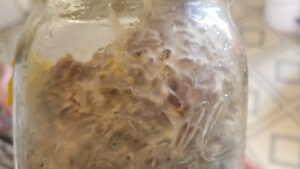
To facilitate grain spawn production six 1-quart wide-mouth mason jars and fourteen 5lb bags were filled with fully hydrated (60% water) rye berries. The rye berries were prepared by soaking them in water for 24 hours to germinate endospores that may potentially be in the rye. Then the rye berries were boiled for 10 minutes and then allowed to air dry in a strainer. Once the rye berries have cooled to 75°F they were loaded into the bags and mason jars. The bags were sterilized in a pressure cooker for 2 hours at 15 PSI. The jars were sterilized for 1 hour at 15 PSI.
Using the prepared grain spawn the commercially available sample of colonized COTW was cloned to a sterile mason jar of rye berry grow medium. A sterile scalpel was used to take a tissue sample from the colonized petri dish and place it into the jar of rye berries. When the jar was fully colonized it was divided into six bags of rye berry grow medium under a laminar flow hood using sterile technique.
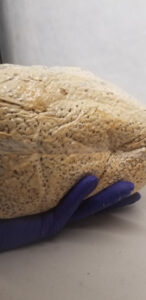
Twenty-two samples of COTW were collected from the public, these samples were cloned in our laboratory under a laminar flow hood following sterile technique. The samples were washed with 70% isopropyl alcohol solution before being taken under the laminar flow hood to be cloned. Once washed the sample was broken by hand into two parts, the first part is discarded while the second part is held under the airflow from the hood. Using a sterile scalpel a 1mm biopsy is made to the inside of the COTW sample that has been exposed to the flow hood after breaking the sample into two parts. The tissue biopsy is placed into the prepared petri dishes of PDA grow medium . The samples took one week to show signs of growth and four weeks to fully colonize the PDA medium. Eight of our samples contaminated with unidentified fungus or bacteria.
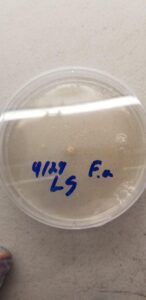
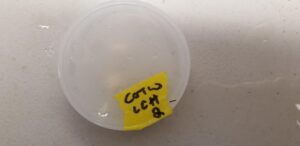

Using the same technique used for cloning the commercial samples 5 grain jars and 5 bags of grain spawn were produced using biopsies of the wild samples. The five sawdust bags created by conducting a sterile transfer from the grain jars to the sawdust bags. The bags were labeled according the the following chart:
| Label | Sample |
| A | Commercial laetiporus sulphureus |
| B | Wild sample laetiporus cincinnatus |
| C | Wild sample laetiporus sulphureus |
| D | Wild sample laetiporus sulphureus |
| E | Wild sample laetiporus cincinnatus |
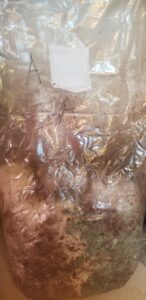
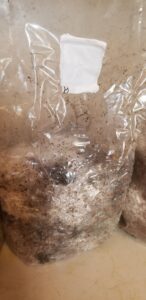
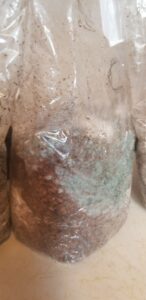
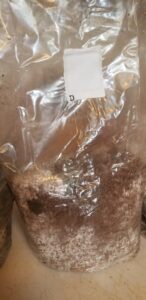
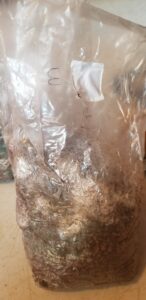
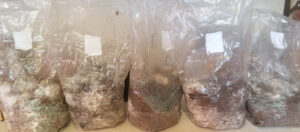
All 5 sawdust bags contaminated with a green growth. It is suspected that this is trichoderma. Bags did form sclerocia (pre-fruiting body formation) however they never fully formed fruiting bodies.
Because of the 100% contamination rate of inoculated sawdust substrate bags used, there were no fruiting bodies produced so no PRC tests were able to be run.
The second objective is to collect wild strains for further research and study. We will place various ads in physical publications as well as social media to alert people of our project. People will be instructed to send us wild mushroom samples of COTW along with the location they found them,
Moving forward if successful fruiting bodies are obtained we would propose the following procedure: For each strain grown out on petri dishes we would additionally preform a PCR test using an OpenPCR (OpenPCR Inc) machine to test for the existence of previously identified PCR Primer Sequence in the DNA of the samples. Samples would be transferred and cleaned in .5ml sample tubes. DNA will be extracted using Borges et al. (1990) using a lysis buffer for suspension. For our purposes we will be using the following previously identified PCR primer chains ITS1, ITS2, ITS3, and ITS4. Our PCR . Once we have obtained confirmation of successful PCR amplification process the samples will be sent to a 3rd party lab to preform DNA sequencing via the fluorescent dye-terminator method. Once one has isolated the wild sample on PDA petri dishes, we would then transfer them to agar slants in 50ml test tubes. These slants will contain the PDA solution used above as well as a hardwood piece of wood. The hardwood PDA slants will then be stored at ~40F for later trials of COTW.
Collecting samples of wild mushrooms from the public was very effective. We were able to receive twenty two unique samples in total for our study. These samples were sourced by community members who took interest in the study. All mushrooms received were the correct species.
Cloning the wild samples was also fairly successful. Samples would show contamination on the first two transfers, but would be clean on the third transfer. In the future it might be worth experimenting with supplementing the PDA for the petri dishes with hydrogen peroxide to discourage growth of contamination. It was also noticed that due to the thickness of chicken of the woods, it is a very easy mushroom to clone. When breaking the chicken of the woods open, it will expose a large area of sterile material to transfer to the petri dish.
Creating grain spawn bags yielded very slow results. While the bags did colonize fully, the time to do so was twice that of the oyster mushrooms we normally grow. Oyster mushrooms will take two weeks on average to fully colonize in our commercial setting. To contrast the COTW grain spawn we produced took four weeks (twice the time) as oyster mushrooms.
Creating sawdust spawn was extremely unsuccessful using our process. Our 100% contamination rate at this stage hints that something in our environment or process is impedes the growth of chicken of the woods. The long colonization time of chicken of the woods means the substrate may need to be per-treated or sterilized additional times.
We were unable to run PCR tests on our samples we obtained. Near the end of our project we experienced a failure in our refrigeration unit which we stored our slants and petri dishes inside. The failure caused the unit to heat to 122°F, killing our slants and petri dishes. If we engaged in a similar study a more robust refrigerator would be proposed. Additionally it may be prudent to store slants in a separate location as a backup, although this may be too cost prohibitive to actually do in pratice.
Our goal of growing COTW in an indoor grow room for commercial production was not met. We were able to successfully clone wild and commercial samples of Chicken of the Woods onto PDA (Potato Dextros Agar) petri dishes as well as jars and bags of grain using commercial practices. The cloning practices used on wild mushrooms was fairly successful with a failure rate of 37% (8 out of 24 total).
However we ran into major issues when transferring the fully myceliated grain jars to sawdust substrate used to fruit the COTW mushroom. We lost 100% of our sawdust bags to contamination. We suspect due to its green color is suspected to be trichoderma. In a commercial grow setting where oyster mushrooms are grown via pasteurized substrate trichoderma is common place. It is unknown how the bags became contaminated, however unlike oyster mushrooms, chicken of the woods is not resilient against contamination. Further study is needed to understand what part of our sterile technique is allowing for contamination.
Our farm is still planning on moving forward with additional trials of Chicken of the Woods. In future attempts we will attempt to learn from the sawdust spawn contamination.
Education & Outreach Activities and Participation Summary
Participation Summary:
Produced a one page flyer to inform the public about the project and solicit samples of COTW. These were displayed at our weekly farmers markets as well as at Peach Fest (Romney WV), Sunflower Fest (Winchester VA).
Farmers involved with the project were encouraged to discuss the project and its intended outcomes with the public at length when attending events.
A press release to inform the public about the project was shared via the Hampshire Review, The Mushroom Growers Newsletter, West Virginia Farm Bureau Newsletter, Cornell Small Farms Program email list, and to the WV Extension network via our grant advisor.
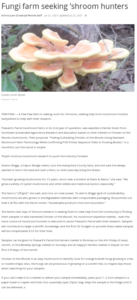
Instagram and Twitter were used to promote the study and the collection of samples as well. Three promoted ads ran on Instagram reaching 5,537 unique accounts.

On March 18th-20th we ran a booth at the Mother Earth News Spring Conference and Organic Growers School at Mars Hill University in Mars Hill NC. We raised awareness of our study by creating a sign for our table to be displayed during the event. Reception from event attendees was positive, there was a lot of interest expressed in the study and the processes used.
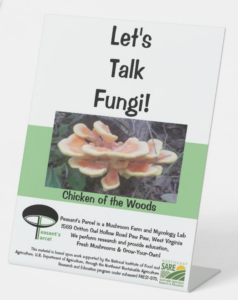
Produced guide to cloning wild Chicken of the Woods via tissue samples. The procedure describes prerequisites required to perform sterile tissue sampling. This guide will be edited as we update our procedures and will be supplemented with additional information on growing Chicken of the Woods. Procedure for Cloning Wild Chicken of the Woods
Learning Outcomes
Six farmers have reached out expressing interest in our results.
Our farm plans on commercially harvesting COTW pending success of this project.
Project Outcomes
The collection of samples COTW samples from the community was very successful. Not only did this provide a source of COTW samples for our study, but it facilitated a lot of interest in the communities where have farmers markets. We were approached multiple times at markets by various people that they felt the work we are doing is important. It was great to hear that people were excited about the possibility of growing COTW indoors.
Our study had both success and failures. The biggest success was the collection and cloning of COTW samples form the public. Every sample collected was viable for transfer to petri dishes and showed signs of growth.
The biggest challenge presented was contamination. Due to COTW's long colonization our sterilization techniques we used on the fruiting substrate were insufficient to produce fruiting bodies. In future studies different grow mediums and vessels (IE: bags, tubing), sterilization techniques should be investigated.
We plan to continue to attempt to fruit the COTW samples we collected with different substrates and sterilization techniques.
Small to medium sized indoor mushroom farms interested in attempting to add COTW to their offerings will hopefully benefit from our results.